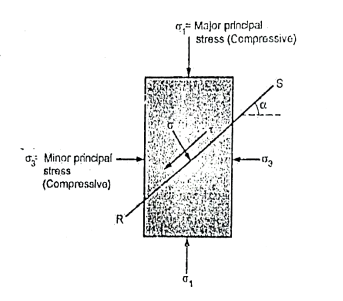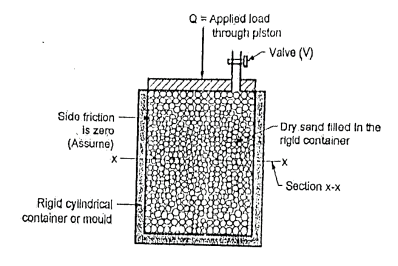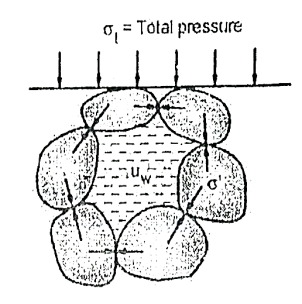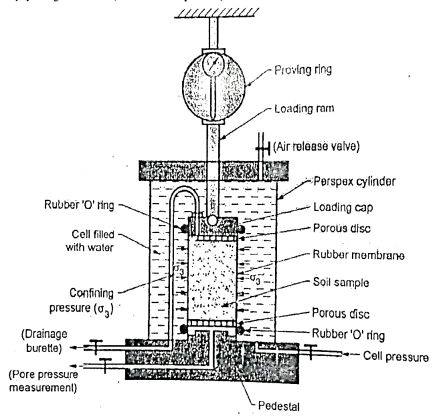Unit - 4
Shear Strength of Soil
Key Takeaways:
It is the force applied along or parallel to a surface or cross-section, instead of being applied perpendicular to the cross-section. Shear stress is this force divided by the area on which it acts. And the capacity to withstand the maximum shear stress without occurrence of failure is the shear strength of the material.
Key Takeaways:
Shear strength can be defined as the maximum value of shear stress that can be mobilized within a soil mass. If this value is equalled by the shear stress on any plane or surface at a point, failure will occur in the soil because of movement of a portion of the soil mass along that plane or surface.
Principal planes:
There are three principal planes as,
Principal stresses:







 +
+ 2 =
2 = 2
2
Where,  = Normal stress
= Normal stress
 = Shear stress
= Shear stress
 1= Major principal stress
1= Major principal stress
 = Minor principal stress
= Minor principal stress
The co-ordinates of centre of circle are  =0 and
=0 and
 =
= and its radius is
and its radius is 
Mohr's circle stress:

Fig.4.1: Soil Specimen



Fig.4.2: Mohr’s stress circle for cylindrical specimen








Key Takeaways:
The circle on which the co-ordinates of points showing the normal and shearing stresses on inclined planes at a given point is termed as mohr circle of stress.
i.e.,  f=f (
f=f ( )
)
 f = shear stress
f = shear stress
 = normal stress
= normal stress
Equation (i) becomes,
 f =s= f (
f =s= f ( )
)
S =shear strength.

Fig.4.3: Mohr’s Theory
Columb later modified Mohr’s equations and gave the following equation.
S=c+ 
∴Thus, Mohr envelope is replaced by straight Line

Fig.4.4: Mohr’s coulomb envelope
We can say that c is intercept on c axis and is angle made by envelope with  axis. The component 'c' of shear strength is called as cohesion which is independent of normal stress which hold soil particle together and d-represent angle of internal friction. Failure occurs when Mohr circle touches failure envelope or one can say at a maximum obliquin (Bmax) in which resultant touches Mohr circle and when
axis. The component 'c' of shear strength is called as cohesion which is independent of normal stress which hold soil particle together and d-represent angle of internal friction. Failure occurs when Mohr circle touches failure envelope or one can say at a maximum obliquin (Bmax) in which resultant touches Mohr circle and when  and c gives a critical combination failure occurs.
and c gives a critical combination failure occurs.
Incase where c=0 the graph starts from origin and equation becomes.
S= 
In case where =0 i.e., friction less or fully cohesive soil the line will be horizontal. Later it will be found that c and depends upon number of factors like water content drainage conditions and lesting condition. Thus, terzaghi shows that the effective stress controls the shear strength and hence the equation gets modified
=0 i.e., friction less or fully cohesive soil the line will be horizontal. Later it will be found that c and depends upon number of factors like water content drainage conditions and lesting condition. Thus, terzaghi shows that the effective stress controls the shear strength and hence the equation gets modified
:. s = c’+tan
c' =Effective cohesion intercept
 Effective angle of shearing resistance
Effective angle of shearing resistance
 = Effective stress
= Effective stress
This above equation is called as Mohr Coulomb equation for shear strength of soil.

Fig.4.5: Soil with internal friction and cohesion

Fig.4.6: Cohesionless soil

Fig.4.7: Frictionless soil
Key Takeaways:
Mainly shear failure in soil occurs by slippage of particle due to shear stress. Shear stress at failure normally depend upon normal stresses on the potential failure plane.
a) Effective stress governs volume changes in soils.
b) Effective stress ( l) Total stress (
l) Total stress ( )-pore pressure(uw)
)-pore pressure(uw)
c) Effective stress controls shearing strength of soils.
:. Total stress = component of stress carried by solid particles + pressure in the fluid in the void space.
 av =
av =
Where,  av =Average stress; A= sectional area of the cylinder
av =Average stress; A= sectional area of the cylinder
Any plane like x-x do not pass through all the points of contact, but many of the grains are cut by the plane x-x and the actual points of contacts seems like a wavy form.
The average stress which is responsible for the deformation of the soil mass is called as effective stress or intergranular stress see Fig. for better understanding. Note that o, o is the effective stress.

Fig.4.8: Specimen

Fig.4.9: Intergranular pressure

Fig.4.10: Pore water pressure

Fig.4.11: The effective stress principle

Fig.4.12: The effective stress principle
uw = neutral stress=Q/A
where, Q=load applied by piston
A=sectional area of the cylinder
Uw =pore pressure or neutral stress
Total pressure ( ) =
) =  + uw
+ uw
Where,  =Intergranular pressure
=Intergranular pressure
Uw =pore water pressure or neutral stress.
For no expulsion of water, uw = 0,
Hence total pressure ( )= Intergranular pressure (
)= Intergranular pressure ( )
)
Fig.shows the concept of total pressure, integranular pressure and pore water pressure.




Key Takeaways:
The pressure which is developed in the water due to external load transmitted to the water in the pore by assuming water to be incompressible is called as pore pressure or neutral stress.

Fig.4.13: Peak and Residual shear strength
Peak Shear Strength:
Residual Shear Strength:
Key Takeaways:
Resistance to a particulars maximum shear stress caused only by strain hardening is termed as peak shear strength or only shear strength of the soil. When the shearing resistance comes at a constant level after a continued large strain then corresponding shear resistance at a constant level is termed residual shear strength.
Cohesionless Soil | Cohesive soil |
1.Gradation | 1.Plastic index |
2.Shape of particle | 2.Clay content |
3.Pressure | 3.Drainage condition |
4.Denseness | 4.Pressure |
5.Moisture |
|
For Cohesionless soil:
For Cohesive Soil:
Stress-Strain Behaviour of Sands:

Fig.4.14: Typical stress-strain behavior of sands from CD test
In both the specimen, the cell pressure is kept constant and axial stress is increased the sample specimen fails in shear.
Stress-Strain Behaviour of Clays:

Fig.4.15: Typical stress-strain behavior of clays from UU test

Fig4.16: Brittle and plastic failure resp.

Fig.4.17: Stress-strain behavior of clay obtained from CD test
Key Takeaways:
The stress-strain behaviour of saturated sand specimen can be well studied by performing drained tests in direct shear tests or triaxial tests.
4.10.1 Direct Shear test:


Fig.4.18: Test arrangement

Fig.4.19: Graph of direct shear test
Advantages and Disadvantages of Direct Shear Test:
Advantages:
Disadvantages:
Key Takeaways:
This is the oldest shear test method in use and still most common because of its simplicity. It is also known as shear box test.
4.10.2 Triaxial Compression test:


Fig.4.20: Triaxial cell
Test procedure:
Following are the various points which explains the test procedure.

Fig. shows the principal stresses on the triaxial specimen

Fig.4.21: Principal stress on the triaxial specimen
In the first stage, cell pressure ( )) is applied on the test specimen and in the second stage, deviator stress (ie. additional axial stress,
)) is applied on the test specimen and in the second stage, deviator stress (ie. additional axial stress,  ) is applied on the sample until the failure of the soil specimen.
) is applied on the sample until the failure of the soil specimen.
 =deviator stress (
=deviator stress ( )+cell pressure (
)+cell pressure ( )
)
 =
= -
-
5. During triaxial loading, outlet valve of drainage burette is kept open so as to have the result for drained loading. This outlet valve is kept closed for an undrained loading.
6. The drainage burette or drainage outlet is connected to the pore pressure apparatus by which pore pressure can be measured.
7. The drainage burette is also connected to the volume measuring apparatus so as to measure change in volume for drained loading.
Advantages of Triaxial Test:
Following is the various advantage of triaxial test
Disadvantages of Triaxial Test:
Key Takeaways:
The triaxial compression test is most efficient and versatile of all the shearing testing methods of any type of soil
4.10.3 Unconfined Compression test:
 f=Cu=qu/2
f=Cu=qu/2

Fig.4.22: Test arrangement

Fig.4.23: Mohr’s circle
Advantages of Unconfined Compression Test:
Disadvantages of Unconfined Compression Test:

Key Takeaways:
This test is especially useful for homogenous cohesive clayey soils. It cannot be used for dry.
4.10.4 Vane shear test, their suitability for different types of soil and advantages & disadvantages:

Fig.4.24: Vane shear test
 =
=
 =
=
Where, = shear strength,
= shear strength,
T = torque applied,
H =height of vanes,
d =diameter of circle formed on rotating vanes.
The arrangement is shown in Fig.
Plotting Strength Envelope:
Determining Shear Strength Parameters of Soil:






Key Takeaways:
This is a test preferred when shear strength of soil in the undisturbed state is required.
There are three types of drainage conditions for shear tests as explained follows:
1. Consolidated-undrained conditions (CU condition)
2. Consolidated drained conditions (CD condition)
3. Unconsolidated-undrained condition (UU condition)
Key Takeaways:
St =
Sr.no. | Sensitivity | Classification |
1 | 1-14 | Normal |
2 | 4-8 | Sensitive |
3 | 8-16 | Very sensitive |
4 | 16-32 | Slightly quick |
5 | 32-64 | Medium quick |
6 | Greater than 64 | Quick |
7 | Less than 1 | Stiff clay |
Key Takeaways:
The ratio of unconfined compressive strength of an undisturbed sample of soil to the unconfined compressive strength of the remoulded sample of same soil at the same water content as in undisturbed soil is called as sensitivity.
Key Takeaways:
It is the property of certain clays or soil by virtue of it gradually regains its lost strength with time if remoulded clay is allowed to rest without change in water content.
References: